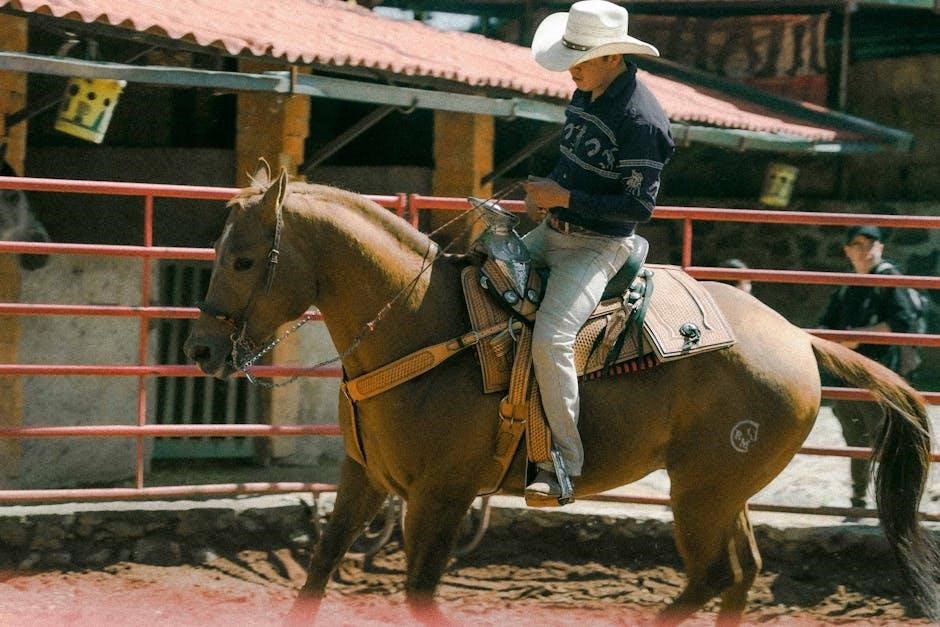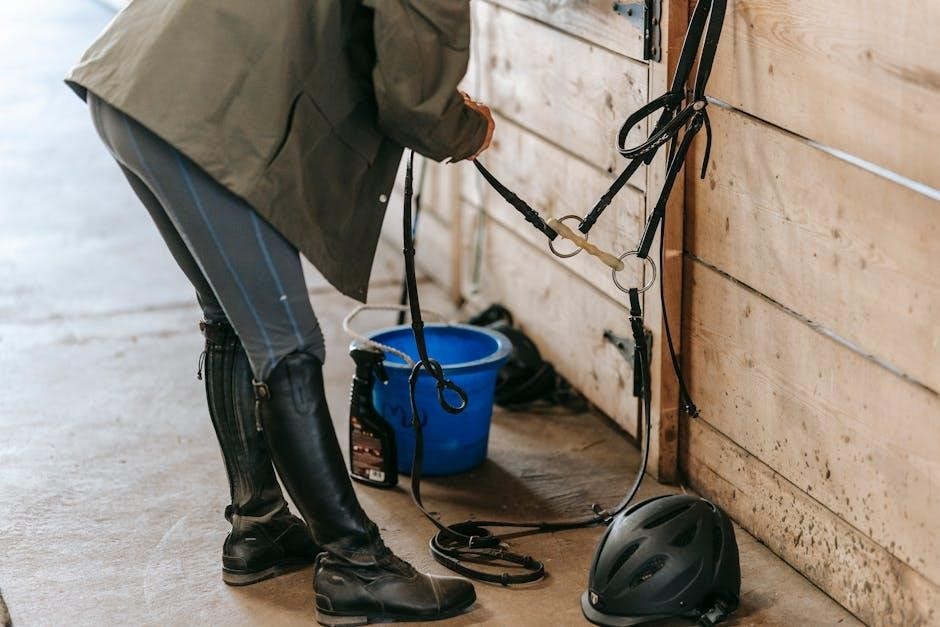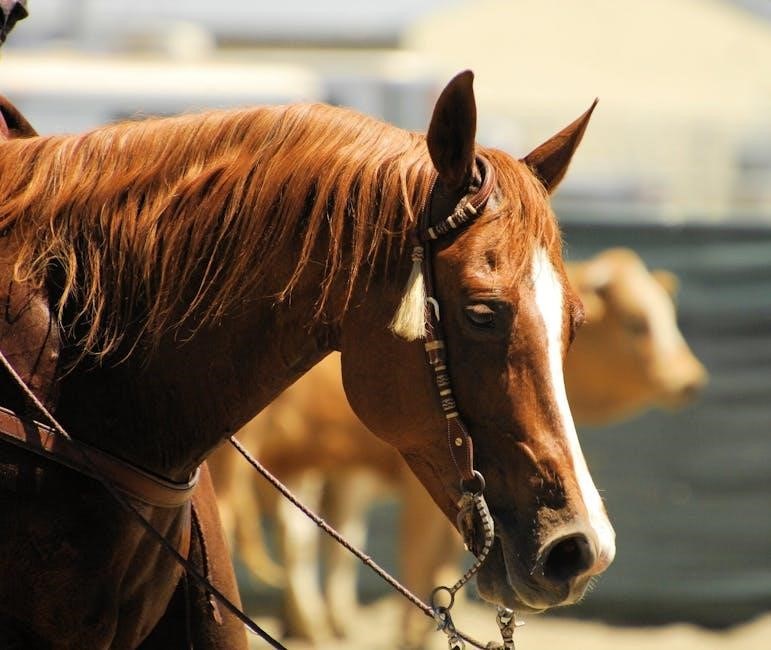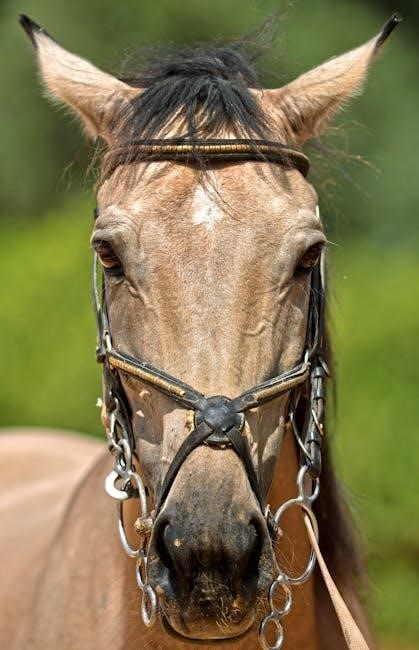A horse bit is an essential tool for communication between horse and rider, designed to guide movement and maintain control gently. Bits vary widely in design, material, and purpose, catering to different disciplines and horse needs. Understanding the correct use and selection of bits is crucial for effective training and ensuring the horse’s comfort. This guide explores the fundamentals of horse bits, helping riders make informed decisions for optimal performance and harmony with their equine partners.
Understanding the Basics of Horse Bits
A horse bit is a metal piece placed in the horse’s mouth to communicate cues from the rider. It works by applying pressure to the mouth, tongue, and bars (the area behind the horse’s front teeth). Proper fit is essential to ensure comfort and effectiveness, as an ill-fitting bit can cause discomfort or confusion. Bits are designed to guide the horse’s movement gently, with pressure varying based on the rider’s reins. Understanding how bits function is crucial for selecting the right one for your horse, ensuring clear communication and a positive training experience. Regular inspection and maintenance are also vital for longevity.

How Horse Bits Work
A horse bit applies pressure to the mouth, tongue, and bars when reins are pulled, guiding the horse’s movement and direction through subtle cues and responses.
The Mechanics of Bit Pressure and Horse Response
A horse bit works by applying pressure to the horse’s mouth, tongue, and bars when the reins are pulled. The pressure is distributed across these areas, prompting the horse to respond by moving its head or altering its gait. The design of the bit determines where and how the pressure is applied, with varying intensities depending on the type of bit. When the horse reacts appropriately, the pressure is released, creating a system of clear communication. Proper fit and rider skill are essential to ensure the bit functions effectively without causing discomfort or resistance.

Types of Horse Bits
Horse bits are categorized into snaffle, curb, and mullen mouth types, each designed for specific purposes and horse needs, ensuring effective communication and control during riding.
Snaffle Bits: Design and Usage
Snaffle bits are the most common type, featuring a jointed mouthpiece that applies pressure to the horse’s bars, tongue, and lips. Ideal for young or sensitive horses, they provide clear communication. The jointed design allows for gentle yet effective control, making them excellent for training purposes. Available in materials like stainless steel or rubber, snaffle bits cater to various horse needs. They are often recommended for horses in early stages of training, as they help establish basic commands and connection between horse and rider. Their simplicity and versatility make them a popular choice for many equestrian disciplines.
Curb Bits: Functionality and Applications
Curb bits are designed for advanced training and specific disciplines, utilizing a lever action to amplify rein pressure. They feature a curb chain that engages the horse’s chin and poll, offering precise control. Curb bits are commonly used in Western riding, dressage, and other high-level competitions. They require skilled handling to avoid discomfort, as improper use can cause pressure points. These bits are ideal for horses that are well-trained and responsive, helping to refine communication and achieve subtle cues. They are not recommended for young or inexperienced horses due to their complexity and potential for misuse.
Mullen Mouth Bits: Features and Benefits
Mullen mouth bits are known for their straight, unjointed mouthpiece, designed to distribute pressure evenly across the horse’s tongue and bars. This makes them ideal for sensitive horses or those with dental issues. The solid design provides clear communication without pinching, promoting relaxation and willingness. Mullen mouth bits are particularly suited for young horses or those transitioning to more advanced training. They are also a popular choice for horses that respond well to steady, consistent pressure. Their simplicity and gentle action make them a versatile option for various equestrian disciplines, offering comfort and effectiveness for both horse and rider.

Choosing the Right Bit for Your Horse
Selecting the ideal bit involves considering the horse’s size, breed, and discipline, ensuring comfort and responsiveness. The rider’s experience and the horse’s sensitivity also play key roles.
Factors to Consider: Horse Size, Breed, and Discipline
Horse size, breed, and discipline are critical factors in choosing the right bit. Larger horses may require stronger bits, while smaller breeds need lighter options. Certain breeds, like Arabians, prefer milder bits due to their sensitive mouths. Discipline also plays a role; dressage often uses double bridles, whereas jumping may opt for gag bits. Understanding these elements ensures the bit suits the horse’s needs, promoting comfort and effective communication. Proper fit and gentle pressure are essential for optimal performance and harmony between horse and rider.

Proper Bit Fitting
Proper bit fitting ensures the horse’s comfort and effectiveness. The bit should sit comfortably, avoiding pressure on sensitive areas like the cheeks or molars. Regular checks and adjustments are essential to maintain a perfect fit, ensuring clear communication and preventing discomfort or resistance.
Ensuring Comfort and Effectiveness
Proper bit fitting is crucial for both the horse’s comfort and the effectiveness of communication. The bit should rest gently on the bars of the mouth, avoiding pressure on the molars or cheeks. Straight bars or mullen-mouth designs are ideal for sensitive horses, while thicker bits can reduce pinching. Regularly checking the bit’s alignment and fit ensures consistent performance. Materials like stainless steel or rubber provide durability and comfort, whilePorts or joints offer additional control for specific disciplines. A well-fitted bit promotes trust, responsiveness, and a harmonious partnership between horse and rider, making it an essential part of proper horsemanship.

Training with Horse Bits
Training with bits requires patience and consistency. Start by introducing the bit gradually, allowing the horse to become comfortable. Use positive reinforcement to encourage acceptance and responsiveness. Begin with simple exercises, such as walking and halting, to establish clear communication. Avoid harsh movements, focusing instead on gentle, precise cues to build trust and understanding between the horse and rider.
Introducing and Using Bits Effectively
Introducing a bit to a horse requires patience and care. Begin by allowing the horse to familiarize itself with the bit in a relaxed environment. Start with short sessions, using positive reinforcement to build trust. When first using the bit, apply gentle pressure and gradually increase as the horse becomes comfortable. Focus on clear, consistent cues to avoid confusion. Always ensure the bit fits properly to prevent discomfort or resistance. By introducing and using bits effectively, you establish a strong foundation for clear communication and effective training.

Maintenance and Care of Horse Bits
Regularly clean bits after use to remove dirt and saliva, ensuring hygiene and comfort. Inspect for wear or damage, storing them dry to prevent rust or corrosion.
Cleaning and Storing Bits for Longevity
Cleaning your horse bit is essential to maintain hygiene and prevent bacterial growth. After each use, rinse the bit with warm water to remove saliva, food particles, and dirt. For more thorough cleaning, use mild soap and a soft sponge, avoiding harsh chemicals that could harm the material. Once clean, dry the bit thoroughly to prevent rust or corrosion. Store bits in a dry place, away from direct sunlight, to preserve their condition and longevity. Regular maintenance ensures your bit remains safe and effective for your horse.
Troubleshooting Common Bitting Issues
Identify issues like discomfort or lack of response. Check bit fit and type, ensuring comfort and suitability. Consult a professional to improve communication and resolve problems effectively.
Addressing Problems and Improving Communication
Identifying common issues like discomfort or lack of response is key. Assess bit fit, ensuring it aligns with the horse’s size and discipline. Choose bits that promote comfort and clear communication. Adjust riding techniques to avoid excessive pressure, fostering trust and responsiveness. Regularly inspect bits for wear and tear, replacing as needed. Consulting a professional can provide tailored solutions. By addressing these factors, riders can enhance their horse’s willingness to respond, leading to a more harmonious partnership and improved performance in various equestrian disciplines;